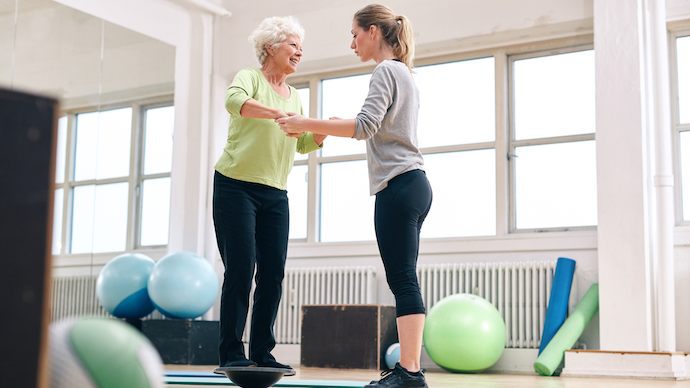Balance Impairment Leading to Falls in Parkinson’s

Eye scans may spot Parkinson’s years before diagnosis
7th November 2024Deep Brain Stimulation surgery was life-changing for my husband
7th November 2024Balance Impairment Leading to Falls in Parkinson’s

Balance Impairment Leading to Falls in Parkinson’s
One of the most challenging symptoms of Parkinson’s disease that fundamentally affects quality of life is balance impairment that can lead to falls.
Falls are one of the major causes of emergency room visits and hospitalisations for people living with Parkinson’s, so finding ways to prevent as many falls as possible is a high priority. Thankfully there are things you can do to improve your stability and decrease the likelihood of falling, and we’ll share some helpful tips and advice below.
Causes of falls in people with Parkinson’s
The most important first step to prevent falls is to identify the cause or causes of the falls. It may seem that everyone living with Parkinson’s falls for the same reason, but in fact, there are multiple factors that need to be assessed.
- Postural instability – this is often referred to as one of the four cardinal features of Parkinson’s (along with resting tremor, bradykinesia or slowness of movements, and rigidity or stiffness). Postural instability refers to the inability to right oneself after being thrown off balance. It is typically tested in the doctor’s office when the neurologist tugs backward on your shoulders to see if you are able to prevent yourself from falling. A person living with Parkinson’s with postural instability may fall if they are jostled. This symptom is not typically present early in the disease and tends to develop as the disease progresses.
- Freezing of gait – This is an abnormal gait pattern that can accompany Parkinson’s in which you experience sudden, short, and temporary episodes during which you cannot move your feet forward despite the intention to walk. In a sense, you’re stuck. This results in the characteristic appearance of the feet making quick-stepping movements in place. However, while the feet remain in place, the torso still has forward momentum which makes falls common in the context of freezing of gait.
- Festinating gait – this is another abnormal pattern of walking that can occur in some people living with Parkinson’s. In this gait, the person takes short steps which get smaller and faster, until it looks like they are almost running. The person may not be able to stop this pattern of walking and may end up hitting up against barriers in order to stop. Festination can lead to falls.
- Dyskinesias – These are extra, involuntary movements that occur in some people as a side effect of Levodopa ingestion. When severe, dyskinesias can throw a person off-balance and cause falls.
- Visuospatial dysfunction – One of the typical cognitive challenges that can affect people living with Parkinson’s is deficits in visuospatial thinking. Deficits in this cognitive area lead to an inability to navigate oneself in three dimensions. A person may have difficulty manoeuvring around obstacles in a room or backing up to sit down in a chair. This difficulty can also lead to falls.
- Orthostatic hypotension – A common non-motor feature of Parkinson’s is drops in blood pressure upon changing head position. This can lead to dizziness and even passing out, which can be interpreted by the bystander as a fall.
- Posture problems – Parkinson’s can be associated with stooped or tilted posture which can contribute to imbalance.
Falls prevention
Understanding which factors are contributing to falls is important since each is treated in a different way:
- Postural instability may be responsive to increases in Parkinson’s medications.
- Sometimes episodes of freezing of gait and gait festination can be reduced with increases in medication as well.
- Bothersome dyskinesias can be treated by adjusting Parkinson’s medications.
- A number of strategies can be used to manage orthostatic hypotension including increased fluids and dietary salt as well as compression stockings. If necessary, medications to increase blood pressure can also be considered.
Another important step in falls prevention – which is necessary to consider whatever the cause of falls – is modification of the home environment, such as:
- Remove rugs and potential obstacles.
- Install grab bars in key areas in which falls are more likely, such as the bathroom.
- Choose the right shoes for you. Some people like rubber soles and some do better with leather soles. Check that shoes are not loose-fitting and provide support. Wear shoes with a slight heel to reduce falling in the backward direction, but no high heels.
- Wear a medical alert bracelet or pendant in case a fall does occur.
A very important part of managing someone who tends to fall, which is often overlooked, is assessing bone density. If thinning of the bones or osteoporosis is detected, medications can be prescribed to improve this, which can prevent a fracture should a fall occur. Your GP can arrange for bone density testing, which is done via a quick and painless x-ray scan.
More Ways to Help Manage Balance
Physical therapy
Once medications are optimised and the home environment is as safe as possible, the next step in the treatment of falls in Parkinson’s is a comprehensive rehabilitative assessment by a trained physical therapist. A physical therapist will then design a program that can address postural instability, freezing of gait, festination of gait, visuospatial dysfunction, and problems with posture, depending on the active problems that are identified.
Assistive devices
Sometimes, the balance is affected to the point that an assistive device for walking becomes necessary.
The use of a cane is often discouraged by physical therapists who are experienced with Parkinson’s. With only one side of the body using the cane, this creates an additional imbalance that is not present when using a walker. In addition, the cane itself can get caught up in furniture or other obstacles and contribute to falls.
Because of these concerns, walkers are often suggested as the assistive device of choice for people living with Parkinson’s. There are many types of walkers that are available for people with walking difficulties:
- Basic walker – this is usually just a metal frame without wheels
- Wheeled walker – a metal frame with wheels. The wheels may be on two or four legs and the wheels may swivel or be fixed
- Rollator – a walker with swivel wheels on all four legs and hand brakes. The brakes typically need to be engaged for the walker to stop. Often the rollator has a seat and a basket for convenience.
- U-step walker – designed specifically with the concerns of people with PD in mind, particularly freezing of gait. The U-step walker has a reverse braking system which means that without engaging anything, the walker is in the braked position and the wheels will not turn. A lever must be gripped or pressed in order for the wheels to turn. Therefore, if freezing of gait occurs, the walker should stay stable.
Your physical therapist can help you determine the walking aid that is best suited for your specific situation.
Should I be using a walker?
This is a critical question that many people living with Parkinson’s grapple with and is best answered for each individual by their neurologist or physical therapist.
People are often concerned that that if they start to use a walker, they may become ‘dependent’ on it, and they won’t be able to walk without one in the future. If your balance is impaired and falling is a concern for you, talk with your neurologist about the potential steps that could improve your situation and prevent falls.
If all adjustments have been made and poor balance is still present, the reality is that it will likely remain that way and will not be worsened or perpetuated unnecessarily by the use of a walker. At that point, a walker becomes essential for you to maintain your independence. Embracing its use is the best way to maximise your quality of life.



